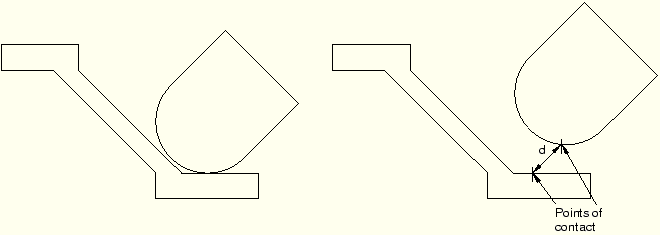
The Translate To tool positions two part instances by translating one instance along a user-defined vector defining the direction of motion until selected faces or edges of the movable part instance are separated by a specified distance from selected faces or edges of the fixed part instance. This tool is not available for orphan mesh parts.
When you use the Translate To tool to position part instances in three-dimensional modeling space, you select faces to come into contact; for part instances in two-dimensional or axisymmetric modeling space, you select edges to come into contact. In addition, when you use the Translate To tool to position axisymmetric part instances, the translation vector must be parallel to the axis of revolution.
When you use the Translate To positioning tool, you can select more than one face or edge from both the fixed and the movable part instances. Selecting multiple faces or edges is useful if you are not sure what part of the model will come in contact when the movable part instance moves along the selected vector. However, for faster processing you should select as few faces or edges as possible.
To translate a movable part instance to a fixed part instance, you do the following:
Select faces or edges from the part instance that will move and from the part instance that will remain stationary.
Prescribe the motion of the movable part instance by defining a translation vector. Figure 13–13 illustrates the selected edges and translation vector.
Define the desired clearance between the selected faces or edges. Figure 13–14 shows the effect of the contact constraint after specifying a clearance value of zero and a clearance value of d.
Figure 13–14 The effect of applying a contact constraint and specifying clearance values of zero and d.

ABAQUS/CAE displays an error message and does not move the part instance if contact between the selected faces or edges is not possible along the translation vector.
Even though you translate the movable part instances until contact occurs with a fixed part instance, the physical proximity of the selected surfaces is not enough to indicate any type of interaction between them. You must use the Interaction module to specify mechanical contact between surfaces. The Translate To positioning tool is satisfied only within a tolerance based on the size of your model. As a result, contact may not be precise unless it is applied between two planar surfaces.
ABAQUS/CAE approximates a curved face with a set of faceted faces. Likewise, ABAQUS/CAE approximates a curved edge with a set of faceted edges. The number of facets depends on the degree of curve refinement that you specified when creating the part in the Part module. Use the box zoom tool ![]() to view the faceting applied to curved faces or edges in the assembly. When you are translating curved faces or curved edges, ABAQUS/CAE computes the contact position using this faceted representation. You may wish to set the curve refinement to a finer setting based on the curvature of faces or edges that you know will be coming into contact. For more information, see “Controlling curve refinement,” Section 50.4.
to view the faceting applied to curved faces or edges in the assembly. When you are translating curved faces or curved edges, ABAQUS/CAE computes the contact position using this faceted representation. You may wish to set the curve refinement to a finer setting based on the curvature of faces or edges that you know will be coming into contact. For more information, see “Controlling curve refinement,” Section 50.4.